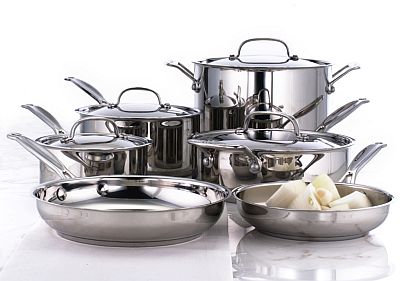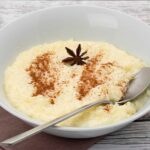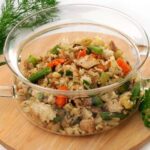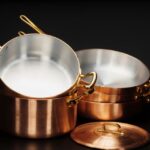What Is Waterless Cooking?
Waterless cooking is a method of cooking in a virtually water-free environment. The food is cooked in natural juices and fats rather than adding fat or additional water.
Sometimes you may need to add a small amount of water. Foods like vegetables can be cooked in their natural juices. On the other hand, foods like rice and other dry foods require a small amount of water to cook, such as 1/8 cup water.
Waterless cooking works by converting water into steam, which requires special cookware. As the heat increases, the liquid in the pot starts to transform into vapor. When you rinse the food and put it in the cookware, there will still be enough drops of water left to create steam. This small amount of water in addition to the natural juices is enough to ensure the food is cooked properly. As long as you keep the waterless cookware covered, your food can be cooked without adding water.

What Is Special about Waterless Cookware?
Waterless cookware ensures that food can be cooked without adding oil or water. To function properly waterless cookware should be made of materials that can retain heat within the cookware. This cookware must transfer heat quickly and distribute heat evenly.
Typical waterless cookware consists of several layers. The cooking surface is made of high-quality stainless steel, which prevents the transfer of a metallic taste to your food. Some manufacturers use surgical stainless steel, the highest quality steel available. The heating surface of waterless cookware consists of layers of copper or aluminum filled with layers of stainless steel. To retain heat for longer, an iron core can be inserted.
A special steam-release valve lid seals the moisture inside the cookware. The main function of the lid is to prevent the escape of moisture from the food. It works by forming a seal with the pot. Due to the increasing heat and steam formation, the food is cooked without adding water and does not dry out. An advantage of this cooking method is that the food does not lose its nutrients and flavors. The iron core helps maintain a constant temperature in the cookware, resulting in faster cooking.
Waterless cookware may have a built-in steam control valve to regulate the steam in the cookware and detect when steam comes out of the valve. The cookware emits a whistling sound to ensure that the user knows when to lower the temperature. This helps save energy and ensures the food is cooked at a regulated temperature.
The Benefits of Using Waterless Cookware?
The main reason why people choose waterless cookware is the fact that it promotes healthy cooking. Further reasons are discussed below.
- Safety. The cooking surface of waterless cookware is safe for food contact. The impermeable nature of the surgical stainless steel prevents harmful heavy metals from getting into the food from the pot. The stainless steel layers ensure that aluminum does not come into contact with your food. The cookware is corrosion-resistant, so the rust from the pans won’t get into your meal.
- Better Nutrient Retention. This style of cooking results in healthier and tastier meals than traditionally prepared foods. With the traditional cooking method, food loses nutrients, taste, and texture. Waterless cooking preserves over 90% of the food’s nutrients.
- Less Fat. The heat in waterless cookware is distributed evenly, preventing the cooked food from sticking and burning. The use of steam eliminates the need to add fat. This can make your meals healthier and save you from high cholesterol and heart disease.
- Better Taste and Appearance. Waterless cooking also makes the food more appealing. Using waterless cookware improves the texture, color, aroma, and taste of food. This will make your meals even more enjoyable.
- Less Time Spent Cooking. Waterless cookware speeds up cooking. Some cookware sets consist of stacked pots that can be heated with a single stove or burner. The stacking cooking function ensures even cooking and also saves time and energy.
- Energy Efficient. Waterless cookware is designed to cook food economically at low heat to save energy. The materials used in the cookware also ensure that cooking is possible even when the heat on the stove is switched off.
- Easy to Clean. Typically, waterless cookware pieces are very durable, easy to clean, and can be washed in the dishwasher. Stainless steel waterless cookware may be more expensive than other cookware materials, but it usually comes with a lifetime guarantee.

What Are the Disadvantages of Cooking with Waterless Cookware?
- This type of cookware is more expensive compared to other types of cookware.
- Waterless cookware is heavy when compared to other cookware types.
- The lids are not dishwasher safe and cleaning the valves could be a hassle.
- The lid must not be removed from the pot while cooking, otherwise heat and moisture can escape.
- You should stay close to the kitchen to hear the steam valve whistling.
- You may need time to adjust to the new cooking method and learn how to convert recipes from a traditional cooking method to a waterless cooking method.

This post contains links to Amazon. The publisher may get paid if You purchase something through the links without additional costs to You.
Waterless Cookware Brands
- Maxam 9-Element Waterless Cookware Set
- BNF 17pc Stainless Steel Waterless Cookware Set
- Chef’s Secret 28 Piece 12-Element T304 Stainless Steel Waterless Cookware




I use waterless and very happy
When food is ready how long can l keep it in it. Can I keep it the whole day before I put it in the fridge tks